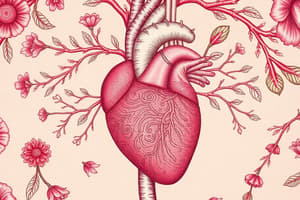Podcast
Questions and Answers
What is the primary mechanism that regulates blood flow in skeletal muscle during exercise?
What is the primary mechanism that regulates blood flow in skeletal muscle during exercise?
- Myogenic and neural mechanisms
- Hormonal factors like angiotensin II
- Metabolic factors in the extracellular fluid (correct)
- Sympathetic vasoconstriction
What is the function of precapillary sphincters in the regulation of blood flow?
What is the function of precapillary sphincters in the regulation of blood flow?
- They control the distribution of blood flow to individual capillaries (correct)
- They are responsible for the active hyperemia response during exercise
- They regulate the contractility of the blood vessels
- They maintain mean arterial pressure (MAP)
Which of the following is NOT a mechanism that can cause vasodilation of blood vessels?
Which of the following is NOT a mechanism that can cause vasodilation of blood vessels?
- Decreased levels of nitric oxide (NO) (correct)
- Increased levels of adenosine
- Increased levels of prostaglandins
- Increased levels of carbon dioxide (CO2)
What is the role of vascular shunts in the regulation of blood flow?
What is the role of vascular shunts in the regulation of blood flow?
Which of the following is a key intrinsic mechanism that regulates blood flow in capillary beds?
Which of the following is a key intrinsic mechanism that regulates blood flow in capillary beds?
What is the primary function of the extrinsic controls on blood flow regulation?
What is the primary function of the extrinsic controls on blood flow regulation?
Which of the following is a control mechanism for regulating blood flow to the brain?
Which of the following is a control mechanism for regulating blood flow to the brain?
What is the consequence of a mean arterial pressure (MAP) below 60 mm Hg in the brain?
What is the consequence of a mean arterial pressure (MAP) below 60 mm Hg in the brain?
Which of the following is NOT a function of blood flow through the skin mentioned in the text?
Which of the following is NOT a function of blood flow through the skin mentioned in the text?
What happens to cerebral vessels when the mean arterial pressure (MAP) increases?
What happens to cerebral vessels when the mean arterial pressure (MAP) increases?
Which of the following statements about blood flow to the brain is correct?
Which of the following statements about blood flow to the brain is correct?
What is the consequence of a mean arterial pressure (MAP) above 160 mm Hg in the brain?
What is the consequence of a mean arterial pressure (MAP) above 160 mm Hg in the brain?
Which of the following structures are responsible for regulating blood flow into capillary beds?
Which of the following structures are responsible for regulating blood flow into capillary beds?
What is the primary function of vascular shunts in capillary beds?
What is the primary function of vascular shunts in capillary beds?
Which of the following structures are responsible for the dilation and constriction of blood vessels?
Which of the following structures are responsible for the dilation and constriction of blood vessels?
What is the anatomical structure of a capillary bed?
What is the anatomical structure of a capillary bed?
What is the primary function of arterioles in regulating blood flow?
What is the primary function of arterioles in regulating blood flow?
Which of the following conditions can contribute to the development of varicose veins?
Which of the following conditions can contribute to the development of varicose veins?
Flashcards are hidden until you start studying



